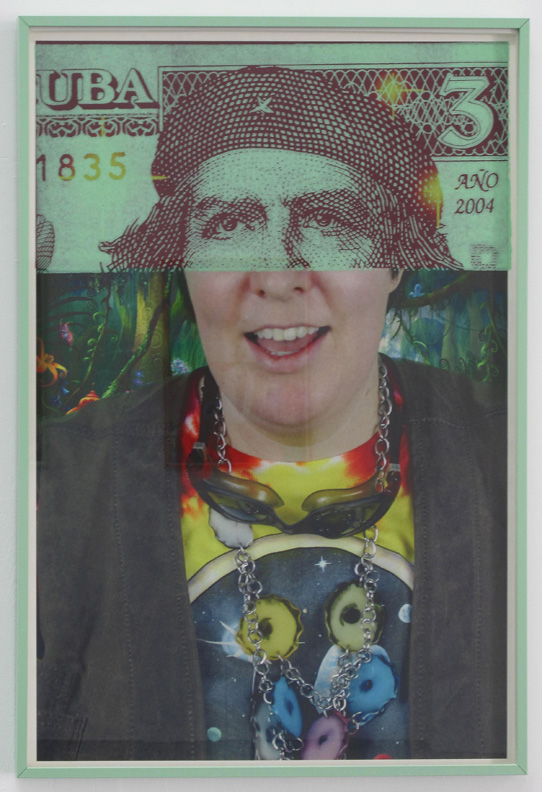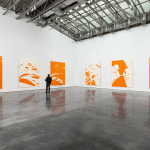
Contributed by Emil Gombos / Melissa Brown is a painter, printmaker, animator, and performance artist whose practice often centers around �paper ephemera� and the manifestations of luck and chance. Her work has drawn from games such as poker, the lottery, and most recently� for her solo exhibition “Past Present Future” at Magenta Plains � tarot cards. I recently met with Melissa in her studio, where we discussed her upcoming show at Roberto Paradise, read each other�s cards, and talked about her string of recent exhibitions in New York.

Emil Gombos: You’ve had an incredibly busy summer with work at Magenta Plains, The Hole, Gavin Brown’s Enterprise, and Shrine. What can we expect from your upcoming solo show at Roberto Paradise?
Melissa Brown: The show is called “Money Shots,” and it’s a body of work I’ve been working on for over a year. The work is a series of hybrid portraits. The top half is a woodcut that’s based on international currency, and the lower half is an inkjet portrait of an artist, and the two different textures come together to form a single character. I�ve been collecting international currency for years, and I started seeing these pictures on Instagram of people holding up currency over their faces. It gave me the idea to figure out a way to actualize that spontaneity as a real print. It’s this mash up between archaic print, digital print, currency, artist, and then in that combination something else comes out, another character emerges. It�s a revealing form of satire to play with objects that are considered to be serious and sacred like money.
EG: In comparison to some of your earlier works, a new visual focal point seems to be portraiture and the figure. What caused this change in your practice?
MB: I’ve traditionally considered myself to be a landscape painter, and I still would consider myself in that realm, mostly because a lot of my paintings deal with the difference between, or the line between, reality and fantasy. Landscape, or representing a space, is a great way to make something exist in both realms. But, recently I became interested in how that can exist for figures, you know, that you could represent two emotions at once or two psychologies at once, a figure can be both a yes and a no, like that duckrabbit illusion. So that’s sort of how I got into drawing figures.

EG: Does this luck or chance encounter often associated with your work play out materially in your practice? In the sense that pulling a print is much like pulling a tarot card? To be more specific: How are the collaged elements of these new works chosen?
MB: Okay so, you, as a printmaker, obviously realize that printmaking is a lot about chance and embracing the mistakes.
EG: Haha yes, freestyle printmaking, at least.
MB: Yeah, the way I like to do it. I’m very interested in randomness and chance having a final voice in an image. I’m always trying to develop a process that allows for that it’s gonna happen naturally anyway � but I reserve an area of the image where that can happen. For instance, in the paintings, I make these scratch off areas where I’ll allow another artist to scratch into the painting and it’s an area that I don’t control, and I’m always surprised by what people put there. Often times what a person scratches in will intuitively connect to the original premise for the painting, in a way that�s not obvious from the visible surface. For the money prints, I take lots of pictures with artists in my studio, then see what they look like against different currencies. The money shot only works when a familiar character comes out of the split, when someone new steps out of it. And that happens randomly. The shots are titled for their character: Baroness is the combo of Shara Hughes, and the portrait on Brazil�s 100 Cruzeiros. Together they seemed like a powerful, regal woman. And then Caroline Wells Chandler came together with Che Guevara, and Che Bro was born, he�s someone you might meet in a hackysack circle.

EG: How are the backgrounds sourced and chosen for the work in �Money Shots�?
MB: There are tons of companies in Hong Kong that sell photostudio backdrops on eBay. I look through hundreds of ads and collect the pics. I set up a document with blanks, and throw a bunch of random stuff in there behind the portrait, and there�s only ever one choice that feels like a whole character.

EG: How is the woodcut print produced?
MB: It�s laser cut. If you open a currency scan in Photoshop it immediately brings you to an anti-counterfeiting website. Photoshop recognizes money. But if you make the scan into vectors, it doesn�t mind as much! The laser woodcuts are printed on top of inkjets.
EG: In a lot of your paintings you focus on views from car windows, often looking out over a landscape, and often including rear view mirror reflections in them as well. As somebody who bounces between between landscape at portraiture, it makes a lot of sense. Could you elaborate on this fixation?
MB: It�s only recently that I started realizing that the rear view mirror motif is something that I’ve done for years, I made paintings ten years ago that included rear view mirrors. While in a car, you’re looking forward through the windshield, and into the future. Above you, you have your rear view mirror and your past. Then there is you, caught in the middle, at the present moment. Different moments in time represented simultaneously. I like the motif because it shows that reality is never what you think it is.
EG: Regarding the work in your recent solo exhibition, “Past Present Future,” at Magenta Plains, was this your first time working with a direct visual focus on tarot cards? You’ve created works like the Tabloid Deck, but there is an overt spirituality to tarot cards that seems to be new in this work for you. Is this a recent interest?
MB: It’s been an interest all along. Olivia Smith from Magenta Plains really dug the idea of rotating the exhibition like cards and having me perform in the space. That basement gallery has a subterranean vibe that felt to me like a Mithraic Temple. For years, I painted on sheet aluminum but recently knocked into corrugated aluminum, which is specifically designed for signage. This made sense to me as a painting support because I’m interested in making paintings feel like signs, or archetypes. Tarot images are simplified symbols used to describe complex meanings, the meanings have to be readable in seconds, as the cards get flipped over. So the paintings in “Past Present Future” functioned like giant cards that rotated throughout the show.
EG: Can you talk about your decision to initially obscure the presentpositioned painting ( All Hands on Deck), as well as reveal the past ( The Ridge) and the future ( The Fool), in your installation of the work at Magenta Plains?
MB: The �past, present, future� arrangement in tarot cards is one of the most basic tarot card readings, like how we pulled cards earlier. One thing that I consider to be true in life is that your present moment is always invisible. It’s only visible in retrospect. For the opening I wanted the painting that was in the present position to be obscured, and then later in the show the present was revealed, and the past and the future were obscured, and then finally the show ended with all three paintings facing out.

EG: Does this relationship between past and present play into your piece in “Goulding the Lolly” at Gavin Brown’s Enterprise, which appropriates Hans Holbein’s The Ambassadors?
MB: I thought that Brian Belott had a brilliant idea for the show and I was happy to be included. The artist’s copy always reveals so much about the copycat. It’s a method of trying on a famous image in order to reveal who you are as an artist. So I loved the concept, and as a painter who uses printmaking, I know all about counterfeiting. The Ambassadors is a painting that I’ve been obsessed with for years, mostly because it contains an anamorphic illusion but I�m also fascinated by the hidden symbolism. Holbein was obsessed with death looming at all times. In The Ambassadors, there�s a fluffy, well dressed dude on the right who represents material success, and on the left is a skinny clergyman. They’re both surrounded by instruments of enlightenment, for measuring astrology, for mathematics, but hovering beneath them is a distorted skull, as if to say: someday you�re both gonna die. Remaking that illusion was a welcome challenge, and the subject matter relates very well, in a sort of roundabout way, to the art world, too.
EG: Where are you expecting to go with your practice, or practices, in the more distant future? If a fortune teller foretold what your art would become in the next few years, what would you want to hear? MB: I would want people in the future to look at the body of work I made in the recent past and say that I went on from this moment in 2016 to create 78 paintings, like a deck of cards. A few years back there was a John Cage retrospective at the National Academy. Apparently, he gridded up the walls and threw dice to determine where to hang his River Rock paintings. I LOVE that. I want to adopt a similar process of randomness to install the card paintings, except that the groupings of my paintings would be configured as �readings.” There are many configurations of cards in the tarot designed to answer specific questions: the Celtic cross, the star, the success spread. So, I hope people see in my future exhibitions in which the paintings could be arranged to investigate particular questions � any question, actually? I�ve always been fascinated by how unperceived registers of reality show up in both of my obsessions: representation and randomness. I would hope for the people of the future to say that I brought them together in my paintings and used the arrangements of them as backdrops for predictive performances.
At the end of our chat, the tarot cards lay face up on the table. I had received Seven of Wands, the King of Pentacles, and the Nine of Swords for the past, present, and future positions respectively. Melissa�s reading, was coming up roses, featuring the Seven of Cups, Ten of Cups, and the Five of Cups.

“Melissa Brown: Money Shots,� Roberto Paradise, San Juan, Puerto Rico. Through October 2, 2016.
Biography: Melissa Brown graduated from the Rhode Island School of Design with a BFA in Printmaking in 1996, and went on to receive an MFA in Painting and Printmaking from Yale University in 1999. She�s recently shown work in solo exhibitions at Essex Flowers and Big Medium, and if you�re in New York, you can still see her work up in the group exhibition “Booby Trap” at The Hole before September 4th.
About the author: Emil Gombos is a writer and text-based artist located in New York City. He recently earned his BFA in Printmaking from the Rhode Island School of Design, and is interested in publishing and pop spirituality. His work explores intersections of academic thought and childish exuberance, as well as printmaking�s relationship to language, publication, and storytelling
Related posts:
PRINTMAKING: Sylvan Lionni at Kansas
Painting Picks: Lower East Side
Dunham donates his printmaking archive to his alma mater






















